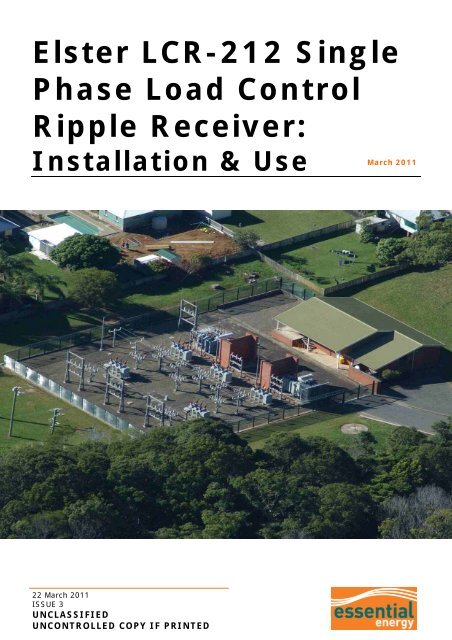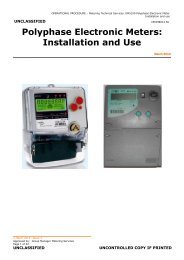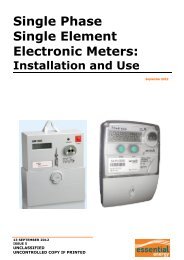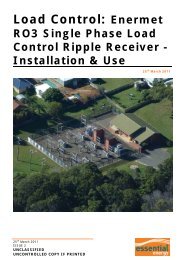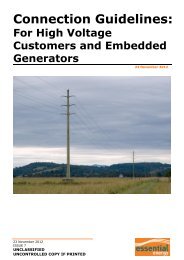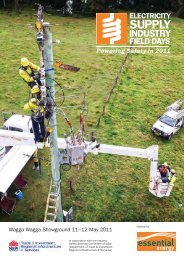Elster LCR-212 Single Phase Load Control ... - Essential Energy
Elster LCR-212 Single Phase Load Control ... - Essential Energy
Elster LCR-212 Single Phase Load Control ... - Essential Energy
You also want an ePaper? Increase the reach of your titles
YUMPU automatically turns print PDFs into web optimized ePapers that Google loves.
<strong>Elster</strong> <strong>LCR</strong>-<strong>212</strong> <strong>Single</strong><br />
<strong>Phase</strong> <strong>Load</strong> <strong>Control</strong><br />
Ripple Receiver:<br />
Installation & Use<br />
March 2011<br />
22 March 2011<br />
ISSUE 3<br />
UNCLASSIFIED<br />
UNCONTROLLED COPY IF PRINTED
UNCLASSIFIED<br />
OPERATIONAL PROCEDURE - <strong>Elster</strong> <strong>LCR</strong>-<strong>212</strong> <strong>Single</strong> <strong>Phase</strong><br />
<strong>Load</strong> <strong>Control</strong> Ripple Receiver Installation and<br />
Use<br />
CEOP8086<br />
PREPARED BY:<br />
LOAD CONTROL OFFICER<br />
AUTHORISED BY:<br />
GROUP M ANAGER T ECHNICAL S ERVICES<br />
ASSISTANCE:<br />
LOAD CONTROL C OORDINATOR<br />
DOCUMENT NUMBER: CEOP8086 - ISSUE 3<br />
This plan is copyright. No part may be reproduced by any process without written permission,<br />
except as permitted under the copyright act.<br />
DISCLAIMER<br />
1 <strong>Essential</strong> <strong>Energy</strong> may change the information in this document without notice. All changes<br />
take effect on the date made by <strong>Essential</strong> <strong>Energy</strong>. A print version is always an uncontrolled<br />
copy. Before using this document, please ensure that it is still current.<br />
2 This document may contain confidential information. Restrictions on the use and disclosure<br />
of confidential information by employees are set out in your contract of employment.<br />
Restrictions on the use and disclosure of confidential information by contractors are set out in<br />
your contract of engagement with <strong>Essential</strong> <strong>Energy</strong>. Sub-contractors are bound by the<br />
confidentiality provisions set out in their contract with the contractor engaged by <strong>Essential</strong><br />
<strong>Energy</strong>.<br />
2011 E SSENTIAL E NERGY<br />
22 March 2011 - Issue 3<br />
Approved By: General Manager Technical Services<br />
Page 2 of 17<br />
UNCLASSIFIED<br />
UNCONTROLLED COPY IF PRINTED
UNCLASSIFIED<br />
OPERATIONAL PROCEDURE - <strong>Elster</strong> <strong>LCR</strong>-<strong>212</strong> <strong>Single</strong> <strong>Phase</strong><br />
<strong>Load</strong> <strong>Control</strong> Ripple Receiver Installation and<br />
Use<br />
CEOP8086<br />
CONTENTS PAGE<br />
1 INTRODUCTION ........................................................................................... 5<br />
2 FEATURES OF THE <strong>LCR</strong>-<strong>212</strong> LOAD CONTROL RECEIVER ..................................... 5<br />
2.1 Receiver Indications ......................................................................................6<br />
2.2 Receiver Connections and Installation Instructions.............................................7<br />
3 OPERATING PRINCIPLE ................................................................................. 7<br />
3.1 Decoder ......................................................................................................7<br />
3.2 Time Base ...................................................................................................8<br />
3.3 Internal Clock ..............................................................................................8<br />
3.4 Microcontroller .............................................................................................8<br />
3.4.1 Memory.................................................................................................. 8<br />
3.4.2 Serial Interface........................................................................................ 8<br />
3.5 Power Supply ...............................................................................................8<br />
3.6 Output Relays ..............................................................................................8<br />
3.7 Real Time Clock (Optional).............................................................................8<br />
4 RECEIVER FUNCTIONS .................................................................................. 9<br />
4.1 Switching On/Off ..........................................................................................9<br />
4.2 Restoration of Supply ....................................................................................9<br />
4.3 Loss of Supply..............................................................................................9<br />
4.4 Wiping Timer ...............................................................................................9<br />
4.5 Cyclic Switching............................................................................................9<br />
4.6 Signal Absence Sensing (SAS) ...................................................................... 10<br />
5 SCOPE OF FUNCTIONS .................................................................................10<br />
5.1 Conventional Decoder.................................................................................. 10<br />
5.1.1 Number of Switching Commands...............................................................10<br />
5.1.2 Multiple Switching Commands ..................................................................11<br />
5.1.3 Memory Function ....................................................................................11<br />
5.1.4 LOOP Function........................................................................................11<br />
5.1.5 Timer Function without VERSACOM ...........................................................11<br />
5.2 VERSACOM Decoder.................................................................................... 11<br />
5.2.1 VERSACOM Function ...............................................................................11<br />
5.2.2 Timer Function with VERSACOM ................................................................12<br />
5.2.3 Special Features .....................................................................................12<br />
6 RIPPLE CONTROL SYSTEMS ..........................................................................12<br />
7 RECEIVER STATUS ......................................................................................13<br />
8 MECHANICAL DESIGN ..................................................................................13<br />
9 PROGRAMMING AND TEST EQUIPMENT ..........................................................13<br />
22 March 2011 - Issue 3<br />
Approved By: General Manager Technical Services<br />
Page 3 of 17<br />
UNCLASSIFIED<br />
UNCONTROLLED COPY IF PRINTED
UNCLASSIFIED<br />
OPERATIONAL PROCEDURE - <strong>Elster</strong> <strong>LCR</strong>-<strong>212</strong> <strong>Single</strong> <strong>Phase</strong><br />
<strong>Load</strong> <strong>Control</strong> Ripple Receiver Installation and<br />
Use<br />
CEOP8086<br />
9.1 Attachment A - Technical Data of the <strong>LCR</strong>-<strong>212</strong>................................................ 15<br />
9.2 Attachment B - Wiring Diagram and Installation Template ................................ 16<br />
10 KEY TERMS AND DEFINITIONS ......................................................................17<br />
11 REVISIONS.................................................................................................17<br />
22 March 2011 - Issue 3<br />
Approved By: General Manager Technical Services<br />
Page 4 of 17<br />
UNCLASSIFIED<br />
UNCONTROLLED COPY IF PRINTED
UNCLASSIFIED<br />
OPERATIONAL PROCEDURE - <strong>Elster</strong> <strong>LCR</strong>-<strong>212</strong> <strong>Single</strong> <strong>Phase</strong><br />
<strong>Load</strong> <strong>Control</strong> Ripple Receiver Installation and<br />
Use<br />
CEOP8086<br />
1 INTRODUCTION<br />
To introduce a standard arrangement for the installation and use of the <strong>Elster</strong> <strong>LCR</strong>-<strong>212</strong><br />
<strong>Single</strong> <strong>Phase</strong> <strong>Load</strong> <strong>Control</strong> Ripple Receiver across <strong>Essential</strong> <strong>Energy</strong>.<br />
The scope of this document covers the use of the <strong>LCR</strong>-<strong>212</strong> receiver to switch and control<br />
electrical load for tariff and real time load control functions.<br />
This Code of Practice forms an integral part of <strong>Essential</strong> <strong>Energy</strong>’s standard load control<br />
ripple receiver arrangements and will ensure a common approach to both the programming<br />
and commissioning of ripple control receivers.<br />
2 FEATURES OF THE <strong>LCR</strong>-<strong>212</strong> LOAD CONTROL RECEIVER<br />
• Use of a fully digital filter for selection of the audio frequency<br />
• Processing of all conventional ripple control protocols<br />
• Processing of a second protocol with secured data transmission<br />
• Integrated timer for autonomous running of work schedules, also as a function of days<br />
of the week<br />
• Remote definition of switching time parameters<br />
• Enabling and disabling of work schedules<br />
• Timer buffering via a real time clock with supercap<br />
• Memory function as a backup<br />
• Bottom connected<br />
• Programmable.<br />
22 March 2011 - Issue 3<br />
Approved By: General Manager Technical Services<br />
Page 5 of 17<br />
UNCLASSIFIED<br />
UNCONTROLLED COPY IF PRINTED
UNCLASSIFIED<br />
OPERATIONAL PROCEDURE - <strong>Elster</strong> <strong>LCR</strong>-<strong>212</strong> <strong>Single</strong> <strong>Phase</strong><br />
<strong>Load</strong> <strong>Control</strong> Ripple Receiver Installation and<br />
Use<br />
CEOP8086<br />
2.1 Receiver Indications<br />
LED Indications<br />
The <strong>LCR</strong><strong>212</strong> has two Led’s to indicate the function and the status of the receiver.<br />
LED 1: (green) indicates evaluation of audio frequency pulses.<br />
LED 2: (red) indicates the corresponding function status of the receiver as follows:<br />
0.2 seconds ON/1.8 seconds OFF flashing rate normal functioning without AF signal.<br />
0.5 seconds ON/0.5 seconds OFF flashing rate processing of a cyclic switching command.<br />
The red LED shows steady light during reception of a telegram.<br />
22 March 2011 - Issue 3<br />
Approved By: General Manager Technical Services<br />
Page 6 of 17<br />
UNCLASSIFIED<br />
UNCONTROLLED COPY IF PRINTED
UNCLASSIFIED<br />
OPERATIONAL PROCEDURE - <strong>Elster</strong> <strong>LCR</strong>-<strong>212</strong> <strong>Single</strong> <strong>Phase</strong><br />
<strong>Load</strong> <strong>Control</strong> Ripple Receiver Installation and<br />
Use<br />
CEOP8086<br />
2.2 Receiver Connections and Installation Instructions<br />
The receiver connection and installation instructions are shown below.<br />
Under all circumstances, single phase loads only are to be connected to the receiver output<br />
relays. <strong>Control</strong> of multi-phase loads such as poly-phases motors, etc, must be carried out<br />
via a separate external multiphase contactor controlled by one of the three available output<br />
relays.<br />
For installations with multiple phases available to them, the individual single phase<br />
controlled loads may be balanced across the available phases by using the multiple output<br />
relays. For this arrangement, it is still a requirement that one active of one of the available<br />
phases is looped to the receiver active link as per the connection and installation instruction.<br />
It should be noted that installation and connection instructions are provided with each new<br />
receiver and these guidelines must be adhered to. The guideline also acts as a drilling<br />
template for the receiver footprint.<br />
3 OPERATING PRINCIPLE<br />
3.1 Decoder<br />
The <strong>LCR</strong><strong>212</strong> processes all standard ripple control protocols and is also capable of handling a<br />
second protocol with secured data transmission (VERSACOM).<br />
Two decoders are needed due to the fact that two ripple protocols have to be processed:<br />
one for conventional ripple control systems and one for VERSACOM.<br />
22 March 2011 - Issue 3<br />
Approved By: General Manager Technical Services<br />
Page 7 of 17<br />
UNCLASSIFIED<br />
UNCONTROLLED COPY IF PRINTED
UNCLASSIFIED<br />
OPERATIONAL PROCEDURE - <strong>Elster</strong> <strong>LCR</strong>-<strong>212</strong> <strong>Single</strong> <strong>Phase</strong><br />
<strong>Load</strong> <strong>Control</strong> Ripple Receiver Installation and<br />
Use<br />
CEOP8086<br />
3.2 Time Base<br />
The time base is normally derived from the mains frequency. However, it can also optionally<br />
be derived from the crystal oscillator of the microcontroller.<br />
3.3 Internal Clock<br />
The internal clock can be set at a fixed time by a special conventional telegram. Through<br />
the use of VERSACOM, it is possible to synchronise the receiver's clock at any chosen time.<br />
3.4 Microcontroller<br />
3.4.1 Memory<br />
The processor has an integrated ROM, RAM and EEPROM to store parameters and status<br />
data. Status data is stored in the RAM, while parameters transmitted by means of remote<br />
programming are stored in the EEPROM.<br />
3.4.2 Serial Interface<br />
The receiver has a standard RS232 electrical or optical interface which is used for<br />
programming and for reading out status data.<br />
3.5 Power Supply<br />
The standard version of the <strong>LCR</strong><strong>212</strong> is designed for 230/240. The power supply unit, which<br />
is capable of withstanding short circuits, supplies the stabilised power supply voltage for the<br />
individual function groups. It is designed so as to sustain functions in the event of a supply<br />
interruption lasting up to 1.5 seconds.<br />
3.6 Output Relays<br />
With the use of plug-in 40A relays, users have the possibility of fitting up to three relays in<br />
the receiver (see installation and connection diagram).<br />
Relay status is also refreshed every 40 seconds, provided the relays have been triggered<br />
once by means of a switching command or a switching program after connection of the<br />
mains or restoration of the mains power after a failure. This allows correction of<br />
unauthorised relay status changes (anti-tamper).<br />
3.7 Real Time Clock (Optional)<br />
Voltage interruptions of up to approximately 72 hours can be bridged using a real time clock<br />
and supercap. It is possible to use the receiver as a self sufficient remotely controllable<br />
timer in this way.<br />
<strong>LCR</strong>-<strong>212</strong> receivers that have the real time clock option fitted are issued under the acronym<br />
of <strong>LCR</strong>-<strong>212</strong>RTC.<br />
22 March 2011 - Issue 3<br />
Approved By: General Manager Technical Services<br />
Page 8 of 17<br />
UNCLASSIFIED<br />
UNCONTROLLED COPY IF PRINTED
UNCLASSIFIED<br />
OPERATIONAL PROCEDURE - <strong>Elster</strong> <strong>LCR</strong>-<strong>212</strong> <strong>Single</strong> <strong>Phase</strong><br />
<strong>Load</strong> <strong>Control</strong> Ripple Receiver Installation and<br />
Use<br />
CEOP8086<br />
4 RECEIVER FUNCTIONS<br />
4.1 Switching On/Off<br />
When defining the parameters, the switch-on status can be specified separately for each<br />
relay. The execution of switch-ON operations in the receiver can be delayed within a<br />
maximum random delay time in the range from 1 second – 24 hours.<br />
4.2 Restoration of Supply<br />
This function is activated when power is restored, following programming, or when the<br />
mains is connected for the first time. The following actions can be programmed separately<br />
for each of the three relays:<br />
• ON or OFF relay status<br />
• Cyclic switching<br />
• Switching to the relay state prevailing before failure of the mains power<br />
• No reaction.<br />
To avoid abrupt load swings, execution of the switching functions can be randomly delayed<br />
within a preset maximum time. The selected delay time is identical for all three relays and<br />
can be chosen within a range from 1 second – 24 hours.<br />
If the receiver executes a delay when the mains power returns, then commands arriving<br />
during this delay time are acted on and the ROS reaction of the relays addressed is<br />
rendered inactive.<br />
4.3 Loss of Supply<br />
This function is activated in the event of a power failure. It is possible to set the relays to a<br />
preselected switching position after expiry of a definable power failure bridging time of 0.5 –<br />
1.5 seconds.<br />
The following actions can be assigned to the relays after the failure bridging time has<br />
elapsed:<br />
• ON or OFF relay status<br />
• No action<br />
4.4 Wiping Timer<br />
After reception of a command, the addressed relay switches to the ON position and then<br />
independently switches to the OFF position after expiry of a specified time. It is possible to<br />
retrigger the wiping timer function, i.e. the running timer is restarted on receipt of a<br />
repeated command.<br />
A delay time of 1 second – 24 hours and a random delay time can be assigned for execution<br />
of the command.<br />
4.5 Cyclic Switching<br />
A cyclic switching function can be assigned to relays 1 – 3. The cyclic period T applies to all<br />
relays and can be specified within the range of 1 second - 24 hours. The following features<br />
can also be assigned to each cyclic switching command:<br />
• cycle time Tk (ON duration) within the time range from 1 second – 24 hours<br />
• number of switching cycles<br />
• start of switching at cycle time Tk or T – Tk<br />
22 March 2011 - Issue 3<br />
Approved By: General Manager Technical Services<br />
Page 9 of 17<br />
UNCLASSIFIED<br />
UNCONTROLLED COPY IF PRINTED
UNCLASSIFIED<br />
OPERATIONAL PROCEDURE - <strong>Elster</strong> <strong>LCR</strong>-<strong>212</strong> <strong>Single</strong> <strong>Phase</strong><br />
<strong>Load</strong> <strong>Control</strong> Ripple Receiver Installation and<br />
Use<br />
CEOP8086<br />
• random switching delay after receipt of a command (the maximum switching delay<br />
corresponds to the period of the cycle T)<br />
• retriggering<br />
• During a running period, starting of a new cycle can be initiated by means of a<br />
repeated switching command.<br />
• switching position on termination of the cyclic switching<br />
Cyclic switching can be activated by the following events:<br />
• cyclic switching command<br />
• ROS<br />
• schedule 1<br />
4.6 Signal Absence Sensing (SAS)<br />
The receiver's signal absence detection function monitors the time between two valid start<br />
pulses in the network. The following reactions can be specified if no start pulse is detected<br />
within a definable time:<br />
• relay positions of R1 – R4:<br />
o<br />
ON or OFF status<br />
o disable switching program 1-4<br />
o<br />
o<br />
terminate cyclic switching<br />
no reaction<br />
• enable Memory function<br />
• enable a schedule<br />
(enabled schedules can be disabled by means of a special command or by receipt of a<br />
valid start pulse)<br />
5 SCOPE OF FUNCTIONS<br />
5.1 Conventional Decoder<br />
5.1.1 Number of Switching Commands<br />
Up to 14 commands can be programmed for each receiver.<br />
• 4 ON switching commands or restoration timers<br />
• 4 OFF switching commands<br />
• 3 commands for cyclic switching<br />
• 1 command for time synchronisation (not using VERSACOM)<br />
• 1 command for switchover to VERSACOM decoding<br />
• 1 command for schedule disabling (not using VERSACOM)<br />
22 March 2011 - Issue 3<br />
Approved By: General Manager Technical Services<br />
Page 10 of 17<br />
UNCLASSIFIED<br />
UNCONTROLLED COPY IF PRINTED
UNCLASSIFIED<br />
OPERATIONAL PROCEDURE - <strong>Elster</strong> <strong>LCR</strong>-<strong>212</strong> <strong>Single</strong> <strong>Phase</strong><br />
<strong>Load</strong> <strong>Control</strong> Ripple Receiver Installation and<br />
Use<br />
CEOP8086<br />
5.1.2 Multiple Switching Commands<br />
Of a maximum of 14 commands, 11 can be assigned directly to the output relay. It is<br />
possible to assign several commands to the same relay.<br />
• 4 ON or 4 OFF switching commands optionally to relays 1 – 4<br />
• 3 cyclic switching commands optionally to relays 1 – 3<br />
• LOOP function to relay 1 or 2<br />
• Memory function to relay 1 or 2<br />
5.1.3 Memory Function<br />
The Memory function can only be activated by conventional telegrams and can be assigned<br />
to relay 1 or 2. The receiver switching times and positions of the last 24 hours are stored in<br />
a schedule for either relay 1 or 2.<br />
5.1.4 LOOP Function<br />
The LOOP function serves to ensure increased switching reliability. In this case, a timer runs<br />
in the ripple control receiver that independently performs ON/OFF switching operations at<br />
specific times within a 24 hour cycle provided no other commands are received.<br />
5.1.5 Timer Function without VERSACOM<br />
A timer function can be assigned to the receiver with this function. For each relay, a<br />
schedule with 5 ON and 5 OFF switching times each is available to the user.<br />
The switching times can be specified in steps of 1 second within the range from 00:00:01 –<br />
23:59:59.<br />
5.2 VERSACOM Decoder<br />
5.2.1 VERSACOM Function<br />
The standardised VERSACOM transmission protocol (see draft standard DIN 43861, Part 3)<br />
with secured data transmission serves the purpose of remote switching, remote adjustment<br />
and remote programming of ripple control receivers.<br />
• Synchronisation<br />
This function can be used to transmit the current time along with details of the day of the<br />
week. In this way, schedules depending on the day of the week can be activated in the<br />
receiver.<br />
• Schedule Selection<br />
Up to 16 different schedules of the addressed object (relay) can be disabled or enabled.<br />
• Remote Programming of Schedules<br />
When remotely programming the switching times of a schedule in the receiver, the ON and<br />
OFF switching times are transmitted as parameters. The schedules are assigned<br />
permanently to the object and may consist of several ON/OFF switching times.<br />
• ON/OFF Switching Commands<br />
The addressed object is switched to ON or OFF with these switching commands.<br />
• Wiper Timer Switching Command<br />
An object can be activated for a limited time with this command.<br />
• Cyclic Switching<br />
The addressed object executes a cyclic (periodic) switching action when this command is<br />
received.<br />
22 March 2011 - Issue 3<br />
Approved By: General Manager Technical Services<br />
Page 11 of 17<br />
UNCLASSIFIED<br />
UNCONTROLLED COPY IF PRINTED
UNCLASSIFIED<br />
OPERATIONAL PROCEDURE - <strong>Elster</strong> <strong>LCR</strong>-<strong>212</strong> <strong>Single</strong> <strong>Phase</strong><br />
<strong>Load</strong> <strong>Control</strong> Ripple Receiver Installation and<br />
Use<br />
CEOP8086<br />
• OFF Switching Command + Work Schedule Disabling<br />
This command serves to switch all addressed objects to the OFF position and to disable the<br />
associated schedules.<br />
• Receiver Deactivation (OUT of Service)<br />
Receivers can be deactivated with this command, i.e. they no longer react to arriving<br />
remote switching and remote programming commands. Equally, all running work schedules<br />
are disabled and all relays are deactivated.<br />
• Receiver Activation (IN Service)<br />
Deactivated receivers can be activated again with this command.<br />
• Test Command<br />
This command is purely for test purposes.<br />
5.2.2 Timer Function with VERSACOM<br />
Up to 32 work schedules containing several ON and OFF switching times can be defined for<br />
each receiver within the range from 00:00:01 – 24.00.00. The work schedules are<br />
optionally assigned to relays 1 – 4. It is also possible to activate work schedules in the<br />
receiver depending on specific days of the week or public holidays.<br />
5.2.3 Special Features<br />
• Correction to the nominal state after a time synchronisation command.<br />
After a time synchronisation command has been received, the current nominal status<br />
of the relays belonging to all currently active work schedules is corrected in the<br />
receiver.<br />
• Correction to the nominal state after a work schedule selection.<br />
After a work schedule selection command has been received, enabling or disabling of<br />
specific temperature-dependent work schedules, all currently active work schedules<br />
are corrected to the current nominal status.<br />
• Emergency running function.<br />
If all work schedules in the receiver are disabled during load control, it is possible to<br />
assign a work schedule to each relay which is then enabled under the following two<br />
conditions: enabling only if all work schedules are disabled and a transmitter failure<br />
(SAS) is also detected.<br />
• Dynamic work schedule processing.<br />
It is possible to specify the number of work schedules and the number of switching<br />
time pairs when defining parameters.<br />
6 RIPPLE CONTROL SYSTEMS<br />
The <strong>LCR</strong><strong>212</strong> receiver is capable of processing the following ripple control protocols:<br />
• conventional protocols<br />
Identifier<br />
System<br />
0 Zellweger 180 second<br />
1 L & G S 50<br />
2 RWE<br />
3 L & G B telegram<br />
4 Zellweger 60 seconds<br />
5 Pulsadis (CDC or EDF)<br />
6 Ricontic S<br />
7 Ricontic B<br />
22 March 2011 - Issue 3<br />
Approved By: General Manager Technical Services<br />
Page 12 of 17<br />
UNCLASSIFIED<br />
UNCONTROLLED COPY IF PRINTED
UNCLASSIFIED<br />
OPERATIONAL PROCEDURE - <strong>Elster</strong> <strong>LCR</strong>-<strong>212</strong> <strong>Single</strong> <strong>Phase</strong><br />
<strong>Load</strong> <strong>Control</strong> Ripple Receiver Installation and<br />
Use<br />
CEOP8086<br />
8 Zellweger DECABIT<br />
9 L & G S 52<br />
10 L & G S 56<br />
11 ZPA<br />
• the secure VERSACOM protocol<br />
7 RECEIVER STATUS<br />
The following receiver status information is stored in the microcontroller's EEPROM and RAM<br />
and, using a special adaptor, can be read out through the serial interface by a PC or<br />
handheld unit.<br />
• Number of switching actions executed<br />
The number of switching actions executed is counted separately for each relay and is stored<br />
in the RAM.<br />
• Number of test transmissions<br />
Specific test commands can be defined for testing purposes. The number of commands<br />
received is stored in the RAM.<br />
• Last telegram received<br />
The pulse pattern of the last telegram received is stored in the RAM.<br />
• Signal level of the AF voltage<br />
The signal level of the AF voltage of the last received telegram is measured with an<br />
accuracy of +/- 10 % and is stored in the RAM.<br />
• Signal absence sensing<br />
The number of detected transmitter failures is counted and stored in the RAM.<br />
All status information is stored in the microcontroller's internal RAM and is cleared in the<br />
event of a power failure.<br />
8 MECHANICAL DESIGN<br />
The <strong>LCR</strong><strong>212</strong> ripple control receiver can be used for mounting on a meter board or with the<br />
optional meter mounting adaptor, on a meter terminal cover.<br />
The electronic circuitry is mounted on an PCB. The board is covered by a PCB holder, thus<br />
providing shock hazard protection even when the cover of the receiver is open.<br />
The receiver can be equipped with up to 3 relays, counted 1-2-3 from left to right.<br />
The bistable 40A output relays are of the plug-in type. 2 connection terminals for wires up<br />
to a diameter of 10 mm² are available for each relay.<br />
9 PROGRAMMING AND TEST EQUIPMENT<br />
To program the receiver, its RS 232 serial interface is connected either via an optical probe<br />
or an electrical adaptor to a PC or a hand-held programmer LCP.<br />
All receiver parameters such as the frequency, ripple control system and other user-defined<br />
data are transferred to the microcontroller's EEPROM in this way.<br />
22 March 2011 - Issue 3<br />
Approved By: General Manager Technical Services<br />
Page 13 of 17<br />
UNCLASSIFIED<br />
UNCONTROLLED COPY IF PRINTED
UNCLASSIFIED<br />
OPERATIONAL PROCEDURE - <strong>Elster</strong> <strong>LCR</strong>-<strong>212</strong> <strong>Single</strong> <strong>Phase</strong><br />
<strong>Load</strong> <strong>Control</strong> Ripple Receiver Installation and<br />
Use<br />
CEOP8086<br />
It is also possible to execute test switching operations with the programmer however, the<br />
input of the receiver is not tested through the serial interface. To test the input of the<br />
receiver, a TT-2 test transmitter can be used or a remote signal from a frequency injection<br />
plant can be called upon.<br />
When programming receivers not mounted and powered up on a switchboard, a suitable<br />
“receiver power-up cradle” shall be used.<br />
22 March 2011 - Issue 3<br />
Approved By: General Manager Technical Services<br />
Page 14 of 17<br />
UNCLASSIFIED<br />
UNCONTROLLED COPY IF PRINTED
UNCLASSIFIED<br />
OPERATIONAL PROCEDURE - <strong>Elster</strong> <strong>LCR</strong>-<strong>212</strong> <strong>Single</strong> <strong>Phase</strong><br />
<strong>Load</strong> <strong>Control</strong> Ripple Receiver Installation and<br />
Use<br />
CEOP8086<br />
9.1 Attachment A - Technical Data of the <strong>LCR</strong>-<strong>212</strong><br />
Connection data: mains voltage: 230/240V + 11% / -22% or<br />
110V + 11% / -22%<br />
mains frequency: 50Hz - 2% / + 1%<br />
power consumption:<br />
< 1.0W / 10 VA cap<br />
surge voltage resistance:<br />
10kV 1.2/50 in accordance with<br />
IEC 255-4<br />
Filter data: control frequency range: 158Hz – 1350Hz<br />
control frequency selection: Freely selectable by pre-built files<br />
operation voltage:<br />
Uf >= 0.5% Un<br />
non-operating voltage: Unf
UNCLASSIFIED<br />
OPERATIONAL PROCEDURE - <strong>Elster</strong> <strong>LCR</strong>-<strong>212</strong> <strong>Single</strong> <strong>Phase</strong><br />
<strong>Load</strong> <strong>Control</strong> Ripple Receiver Installation and<br />
Use<br />
CEOP8086<br />
9.2 Attachment B - Wiring Diagram and Installation Template<br />
<strong>LCR</strong>-<strong>212</strong> (also covers <strong>LCR</strong>-<strong>212</strong>RTC) wiring diagram and installation template.<br />
22 March 2011 - Issue 3<br />
Approved By: General Manager Technical Services<br />
Page 16 of 17<br />
UNCLASSIFIED<br />
UNCONTROLLED COPY IF PRINTED
UNCLASSIFIED<br />
OPERATIONAL PROCEDURE - <strong>Elster</strong> <strong>LCR</strong>-<strong>212</strong> <strong>Single</strong> <strong>Phase</strong><br />
<strong>Load</strong> <strong>Control</strong> Ripple Receiver Installation and<br />
Use<br />
CEOP8086<br />
10 KEY TERMS AND DEFINITIONS<br />
<strong>LCR</strong>-<strong>212</strong>:<br />
<strong>Elster</strong> <strong>Single</strong> <strong>Phase</strong> <strong>Load</strong> <strong>Control</strong> Ripple Receiver.<br />
<strong>LCR</strong>-<strong>212</strong>RTC:<br />
<strong>Elster</strong> <strong>Single</strong> <strong>Phase</strong> <strong>Load</strong> <strong>Control</strong> Ripple Receiver with Real Time Clock.<br />
11 REVISIONS<br />
Issue Number Section Details of Changes in this Revision<br />
2<br />
3.2 Receiver<br />
Connections and<br />
Installation Instructions<br />
Explanation of receiver use and installation for<br />
consumers with multiphase loads and<br />
multiphase supply’s.<br />
3 All sections Rebranding template<br />
22 March 2011 - Issue 3<br />
Approved By: General Manager Technical Services<br />
Page 17 of 17<br />
UNCLASSIFIED<br />
UNCONTROLLED COPY IF PRINTED


